正在加载图片...

Chapter 9 Catalytic Strategies 3 7 In chymotrypsin,the tetrahedral intermediate transition state is stabilized by a structural feature referred to as the“ ”hole. Ans:oxyanion Section:9.2 8 In proteases such as papain,a residue is activated by hydrogen-bonding to a histidine residue. Ans:cysteine Section:9.1 9 Enzymes that transfer a phosphoryl group from NTP to NMP are referred to as Ans:nucleoside monophosphate kinases Section:9.4 10 A characteristic feature of NMP kinases is a sequence of Gly-X-X-X-X-Gly-Lys that is referred to as the Ans:P-loop Section:9.4 Multiple Choice Questions 1 Which amino acids in chymotrypsin are found in the active site and are participants in substrate cleavage? A)his,ser,asp B)his,ser C)asp,lys D)lys,arg E)his,ser,arg Ans:A Section:9.1 2 How is specificity determined by chymotrypsin? A) interaction of the active site amino acids with the substrate B) binding of the N-terminus amino acid at the active site C) covalent binding of a his residue to the substrate D) conformational change upon binding of substrate E) binding of the proper amino acid into a deep pocket on the enzyme Ans:E Section:9.1 3 Where does cleavage of the scissile bond by chymotrypsin occur? A) between a his and ser amino acid B)on the N-terminal side of a phe or trp residue C)on the C-terminal side of a phe or trp residue D) at the N-terminal amino acid E) on the C-terminal side of an arg or lys amino acid Ans:C Section:9.1 4 Which of the following is NOT a way in which enzymes stabilize a transition state? A) causing the temperature of the environment to increase B) covalent catalysis C) using binding energy D) general acid-base catalysis E) catalysis by approximation Ans:A Section:IntroductionChapter 9 Catalytic Strategies 3 7 In chymotrypsin, the tetrahedral intermediate transition state is stabilized by a structural feature referred to as the “___________________” hole. Ans: oxyanion Section: 9.2 8 In proteases such as papain, a ___________________ residue is activated by hydrogen-bonding to a histidine residue. Ans: cysteine Section: 9.1 9 Enzymes that transfer a phosphoryl group from NTP to NMP are referred to as _______________________. Ans: nucleoside monophosphate kinases Section: 9.4 10 A characteristic feature of NMP kinases is a sequence of Gly-X-X-X-X-Gly-Lys that is referred to as the ______________________. Ans: P-loop Section: 9.4 Multiple Choice Questions 1 Which amino acids in chymotrypsin are found in the active site and are participants in substrate cleavage? A) his, ser, asp B) his, ser C) asp, lys D) lys, arg E) his, ser, arg Ans: A Section: 9.1 2 How is specificity determined by chymotrypsin? A) interaction of the active site amino acids with the substrate B) binding of the N-terminus amino acid at the active site C) covalent binding of a his residue to the substrate D) conformational change upon binding of substrate E) binding of the proper amino acid into a deep pocket on the enzyme Ans: E Section: 9.1 3 Where does cleavage of the scissile bond by chymotrypsin occur? A) between a his and ser amino acid B) on the N-terminal side of a phe or trp residue C) on the C-terminal side of a phe or trp residue D) at the N-terminal amino acid E) on the C-terminal side of an arg or lys amino acid Ans: C Section: 9.1 4 Which of the following is NOT a way in which enzymes stabilize a transition state? A) causing the temperature of the environment to increase B) covalent catalysis C) using binding energy D) general acid-base catalysis E) catalysis by approximation Ans: A Section: Introduction